Understanding Diamond Clarity: Factors and Significance
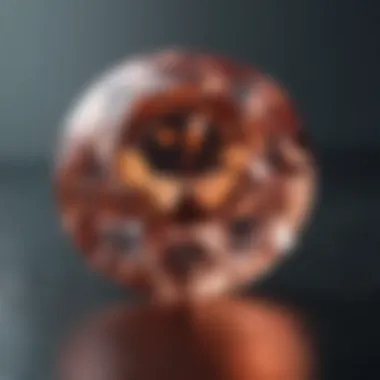
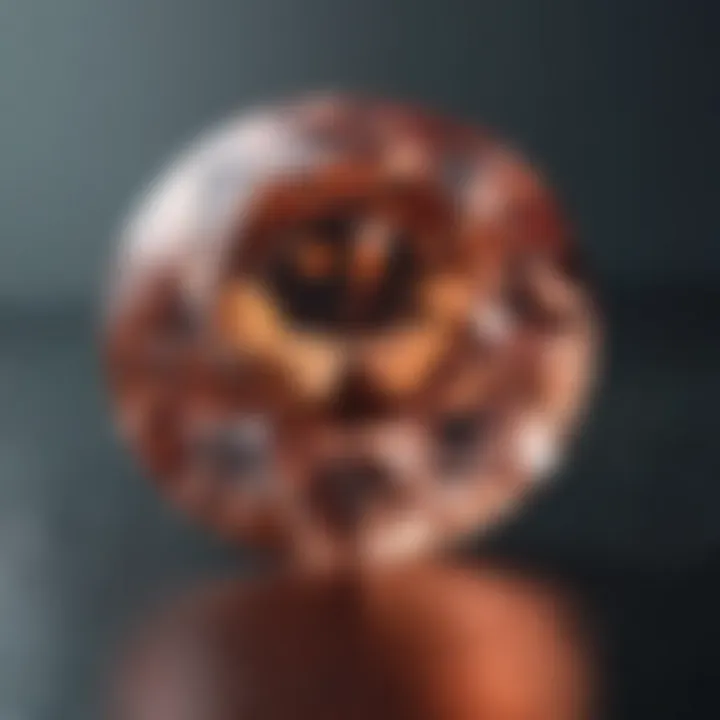
Intro
Diamonds are often perceived as the epitome of luxury and beauty, but there's a deeper tapestry woven into their existence that goes beyond mere aesthetics. Among the various attributes that define a diamond's worth, clarity stands as a cornerstone. It's an intricate factor influencing not just valuation, but also the overall visual appeal of a gemstone. In this exploration, we will dissect the complexities surrounding diamond clarity, illuminating key elements that contribute to its allure and market significance.
Understanding clarity is pivotal, as it serves as a benchmark for evaluating diamonds in different contexts, from jewelry to industrial applications. The significance of clarity in diamonds transcends superficial beauty; it encompasses historical significance, cultural perceptions, and the nuanced interplay between appearance and intrinsic value.
Gemstone Overview
Definition and Origins
Diamonds are crystallized forms of carbon, formed deep within the Earth under extreme pressure and temperature over millions of years. This natural process gives rise to their exceptional hardness, but it also creates imperfections — known as inclusions — that can affect clarity.
From the moment they are unearthed and cut, diamonds are subject to a rigorous evaluation process, taking into consideration their various properties, including clarity. Historically, diamonds have been coveted not only for their beauty but also for their meanings, from symbols of enduring love to tokens of power and status.
Historical Significance
Throughout centuries, diamonds have captured the human imagination. The earliest known diamond was found in India, dating back to the 4th century BC. Trade routes expanded the diamond's reach, leading to a surge in prominence across cultures. In medieval Europe, diamonds were believed to possess protective qualities, showcasing their multifaceted significance beyond mere ornamental use.
In Indian culture, diamonds are mentioned in ancient texts, showcasing their long-standing allure. Today, they still play a crucial role in various cultural practices, notably in marriage traditions, where clarity often conveys purity and commitment.
Gemstone Properties
Hardness and Durability
Diamonds are renowned for their unmatched hardness, rated a perfect 10 on the Mohs scale. This exceptional hardness not only makes them ideal for wear in daily jewelry but also gives them an edge in industrial applications, such as cutting tools. Despite their toughness, it is essential to handle diamonds with care, as the wrong impact can lead to chipping or other damage.
Color and Clarity
When discussing diamonds, color and clarity go hand in hand. While many may focus purely on color grading, clarity plays a vital role in the overall impression of a diamond. Color grades run from D (colorless) to Z (light yellow), but the presence of inclusions can often mask or alter the perceived color of a diamond.
Clarity itself is graded on a scale from Flawless (no inclusions visible under 10x magnification) to Included (inclusions visible to the naked eye). The nuance of grading can be quite subjective, influenced by cultural perceptions and personal preferences.
"The beauty of a diamond lies not just in how clear it is, but also in the journey of its imperfections that tell its story."
In summary, clarity represents more than just a technical measurement in diamond evaluation; it reflects a deeper essence, resonating with value and meaning across various contexts. In the following sections, we will delve further into the factors affecting clarity and its impact on the diamond market, revealing a complex relationship that shapes the way we perceive and value these gemstones.
Understanding Clarity in Diamonds
The concept of clarity is pivotal when it comes to diamonds. In the realm of gemstones, clarity refers to the absence of internal flaws, known as inclusions, and external blemishes. A diamond's brilliance can often be overshadowed by these imperfections, which can influence a buyer's perception and purchasing decision. Understanding clarity helps enthusiasts grasp not just the aesthetic appeal of these precious stones, but also their value in the market. It pits the jewel's physical attributes against subjective factors like personal taste and cultural significance, providing a rounded perspective on what makes a diamond truly desirable.
Defining Clarity
Clarity is an essential characteristic assessed in diamonds, forming a key part of the four Cs—cut, color, carat weight, and clarity itself. The clarity of a diamond hinges primarily on the nature, number, position, and size of any inclusions. For instance, a diamond with few or no visible inclusions when viewed under a microscope is typically rated higher.
When we talk about clarity in practical terms, it’s often categorized into various grades. The Gemological Institute of America (GIA) outlines a grading scale that ranges from Flawless (no inclusions visible) to Included (inclusions visible to the naked eye). This grading not only informs the value of a diamond but also guides consumers in making educated purchase decisions.
A helpful analogy might be likening clarity to a clean window. The clearer the view, the more you appreciate the scenery outside. In diamonds, this "view" translates to how light interacts with the stone, and ultimately, how it sparkles.
Historical Perspective on Clarity Assessment
Historically, the way clarity has been assessed has evolved tremendously. In the early days of gem appraisal, methods were rudimentary and often relied on the naked eye. Jewelers would inspect diamonds under natural light, relying heavily on their experience and instinct. Over time, advancements in technology led to tools like jeweler's loupe and microscopes becoming standard practice, allowing for a much more rigorous evaluation.
The shift didn't stop there; the industry witnessed the standardization of clarity grading systems in the 20th century. It marked a turning point where clarity could be quantified, removing the ambiguity that once clouded gemstone assessments. Different organizations emerged, each developing its unique criteria for grading clarity. Today, the GIA's system remains the gold standard against which all diamonds are measured. This historical progression underscores not just a better understanding of various factors affecting a diamond's appeal but also a commitment to ensuring transparency for consumers.
"Understanding the clarity of a diamond allows us not only to see its beauty, but also to appreciate its story – a tale spanning millennia from deep within the earth to the hands of gem collectors."
In summary, clarity's role is multifaceted. It enriches the diamond's physical presence and deepens its significance in the gemological sphere. Understanding clarity equips both collectors and casual buyers with the knowledge necessary to make informed decisions and enhances their appreciation of this timeless treasure.
The Grading Scale of Diamond Clarity
The grading scale of diamond clarity plays a pivotal role in determining the value and quality of diamonds. Understanding this scale is essential not just for gemologists but also for collectors and consumers. Each detail matters, as it can affect purchasing decisions, resale value, and the overall perception of a diamond's beauty. The clarity grading provides a language through which buyers and sellers can discuss diamonds objectively. By focusing on the grading parameters, one can appreciate how inclusions and blemishes affect a diamond's appearance and, consequentially, its worth in the market.
Overview of the GIA Clarity Scale
The Gemological Institute of America (GIA) developed a widely accepted clarity scale that categorizes diamonds based on how many inclusions or blemishes they exhibit. Here's a breakdown of the scale:
- Flawless (FL): No inclusions and no blemishes visible under 10x magnification.
- Internally Flawless (IF): No inclusions, but there may be some minute external blemishes.
- Very Very Slightly Included (VVS1 and VVS2): Minute inclusions that are very difficult to detect under 10x magnification.
- Very Slightly Included (VS1 and VS2): Inclusions are somewhat easy to see under 10x magnification but are still minor.
- Slightly Included (SI1 and SI2): Inclusions that are noticeable under magnification, with some possibly visible to the naked eye depending on the clarity grade.
- Included (I1, I2, I3): Inclusions visible under 10x magnification and likely visible to the naked eye, affecting the diamond's appearance.
Understanding where a diamond sits on this scale helps consumers make informed decisions when purchasing. A higher rating usually corresponds to a higher price, as these stones are rarer and considered more desirable.
"Clarity, though it's just one aspect of the diamond, often becomes a vital point of discussion in any appraisal or transaction. The GIA clarity scale serves as an industry standard, thus holding significant sway in the marketplace."
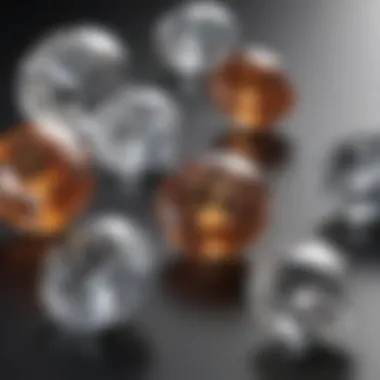
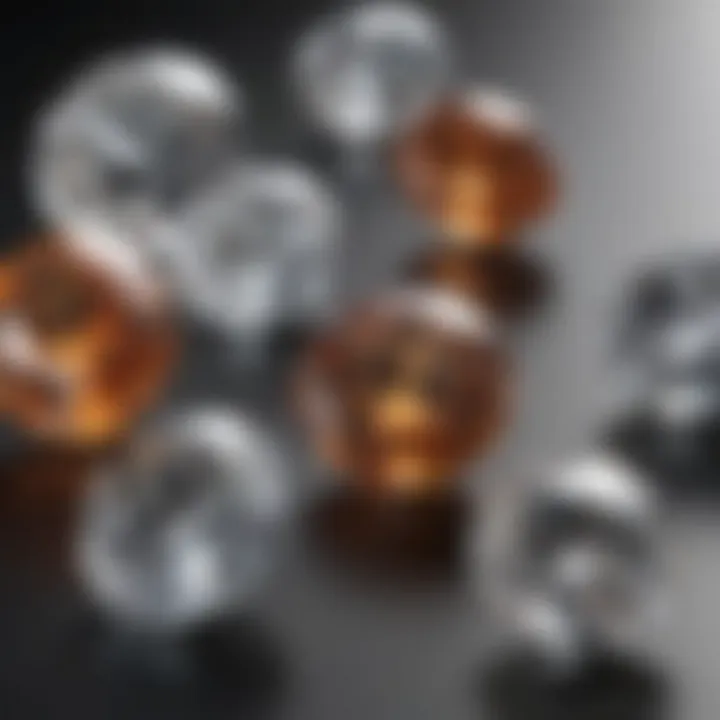
Natural vs. Synthetic Diamonds
When examining clarity, it's crucial to distinguish between natural and synthetic diamonds, as their origins significantly impact clarity characteristics. Natural diamonds form over billions of years deep within the Earth, often resulting in unique inclusions that narrate their geological history. On the contrary, synthetic diamonds, produced in laboratories, can have fewer inclusions, as the process can be tightly controlled.
When assessing clarity:
- Natural Diamonds
- Synthetic Diamonds
- They might contain unique inclusions that reflect their formation journey, often appreciated for their rarity and character.
- Some buyers prefer these for their historical significance.
- Generally feature fewer inclusions, providing a more flawless appearance.
- Often marketed for their ethical and environmental considerations.
The choice between natural and synthetic diamonds can boil down to personal preference, budget, and intended use. Many jewelers highlight the clarity of both types, allowing buyers to choose based on what appeals most to them.
Impact of Clarity on Diamond Value
When it comes to diamonds, clarity plays a pivotal role in determining their overall value. Buyers often perceive clarity not just as a physical quality but as a crucial determinant of brilliance, craftsmanship, and even ethical considerations. Generally, a diamond's clarity refers to the presence or absence of inclusions and blemishes. The cleaner the stone, the more likely it is to command a higher price in the market. However, the relationship between clarity and value isn't merely linear; it intertwines with various factors that paint a fuller picture of what makes a diamond desirable.
Factors Influencing Value Based on Clarity
Several layers contribute to how clarity influences value. Below are some critical elements:
- Type and Size of Inclusions: The kind of inclusions present in a diamond can impact its pricing. For instance, a diamond with a black spot might be less valuable than one featuring a tiny white crystal, even if both belong to the same clarity grade. Hence, not all inclusions are created equal.
- Location of Inclusions: Where the inclusion sits can also affect how the diamond is perceived. Inclusions that are central to the stone can distract from its beauty, while those located at the edge may be less noticeable and therefore less damaging to the stone's overall look.
- Visibility Under Magnification: Depending on how inclusions behave when viewed under magnification, they can lead to different assessments. Jewelers often use tools like a jeweler’s loupe to scrutinize clarity more closely. If a stone exhibits flaws visible even to the naked eye, its value may take a hit.
"A diamond is more than just a pretty face; its essence lies in the subtleties that define clarity and, by extension, value."
Understanding these intricacies is essential for anyone in the gemstone industry or for collectors who aim to make wise investments.
Market Demand and Clarity Considerations
The dynamics of market demand significantly dictate how clarity impacts value. Trends can shift, making particular levels of clarity more desirable at different times. Currently, there's often a strong preference for diamonds that rank high on the clarity scale. However, it's important to know that market preferences can waver.
- Cultural Influences: The perception of what constitutes an 'ideal' diamond can vary greatly across cultures. For instance, some cultures may prioritize clarity while others might emphasize color or cut instead. This cultural lens can shape market demand.
- Investment vs. Aesthetic Choice: Many buyers are becoming more discerning nowadays. For some, investing in diamonds is all about the quality and clarity, hoping for a good return in the future. In contrast, others might prioritize aesthetic preferences over numerical clarity ratings, leading to a potential mismatch between appraisal and actual market preferences.
As such, understanding clarity's impact on value involves looking at both the stone’s physical attributes and the fluctuating trends within its market environment. Buyers who grasp these intricate relationships can better navigate the world of diamonds and make informed decisions.
Inclusions and Their Types
In the realm of diamonds, inclusions hold significant sway. These natural imperfections give each diamond its unique character, shaping its clarity and overall perception. Many collectors and enthusiasts see inclusions not as flaws but as detailed fingerprints forged over millions of years. Understanding inclusions can help make informed choices when selecting a diamond, as they impact its value, aesthetics, and light performance.
Common Inclusions Found in Diamonds
Different types of inclusions occur more frequently than others, and recognizing them can offer vital insights into a diamond's story. The most common include:
- Pinpoints: Tiny crystals, often too small to see without a magnifying glass. They usually appear as small black dots.
- Clouds: Group of tiny, closely packed pinpoints that create a hazy appearance. Clouds can be hard to pinpoint with the naked eye but can influence perceived clarity.
- Feathers: Hairline cracks that resemble the wings of a feather. Although they can sometimes affect durability, they often add to the story rather than detract from it.
- Cavities: Tiny pits on the diamond surface, often caused by natural fractures or rough mining techniques.
- Needles: Long, thin inclusions that can sometimes appear white or transparent but can also be dark, depending on their content.
Each inclusion type interacts differently with light, affecting the diamond’s allure. Understanding these details can enhance both appreciation and assessment of diamond quality.
How Inclusions Affect Light Reflection
Inclusions play a pivotal role in shaping how light interacts with a diamond. A well-cut diamond optimizes light reflection, but inclusions can introduce complexities in this dance of light. Here are some ways inclusions affect light performance:
- Light Diffusion: Some inclusions can scatter light, leading to a sparkle that might appear more pronounced or peculiar. For instance, a cloud inclusion can create a lovely dispersion that casts soft hues.
- Brilliance: The overall brilliance can either be enhanced or diminished by certain inclusions. While some, like pinpoints, might add an intriguing sparkle, others can detract from the clear reflections.
- Color Perception: Certain inclusions can slightly alter the way colors are perceived in the diamond. A clasping feather might refract light in such a way that it highlights the diamond's color rather than washing it out.
- Durability Considerations: Though they might be minor, inclusions such as feathers can potentially weaken a diamond. This aspect can affect how light refracts, posing a curious challenge to diamond admirers looking for longevity without sacrificing beauty.
"Inclusions are like the scars a diamond bears, each telling its own tale and shaping its allure."
In the grand tapestry of a diamond's beauty, inclusions weave the narrative, making meticulous examination essential not only for valuation but also for appreciating the gemstone's inherent story.
Measuring Clarity: Techniques and Tools
In the quest to understand the clarity of diamonds, how we measure this quality plays a pivotal role. Accurately assessing a diamond’s clarity involves a combination of traditional methods and cutting-edge technology. Understanding clarity measurement not only enhances our appreciation of these jewels but also helps gem enthusiasts and collectors make informed decisions. Techniques and tools used in clarity assessment converge practicality with precision, ensuring that the finesse of each stone is adequately represented and valued appropriately.
Microscope Usage in Evaluating Clarity
Microscopes have become a linchpin in the evaluation of diamond clarity. By magnifying the stone significantly, these instruments allow gemologists to scrutinize and discern inclusions and blemishes with remarkable detail. The standard is often to use a 10x magnification loupe, a simple device that fits in the palm of one’s hand and is typically employed for quick examinations.
However, for a more comprehensive analysis, a gemological microscope is employed. These specialized microscopes provide excellent illumination and magnification, up to 40x or even 80x. This is crucial because some inclusions are so minuscule that they elude the naked eye but can impact the overall clarity grade significantly.
- Types of Inclusions: Experienced gemologists can identify various forms such as crystals, feathers, and clouds, each telling a different story about the diamond’s journey.
- Blemishes: Surface imperfections like scratches and pits are also examined. Their location and size can indicate whether a stone may suffer from durability concerns or affect its beauty when set in jewelry.
By utilizing these tools effectively, gemologists can provide prospective buyers and collectors with a clear picture of what they're dealing with.
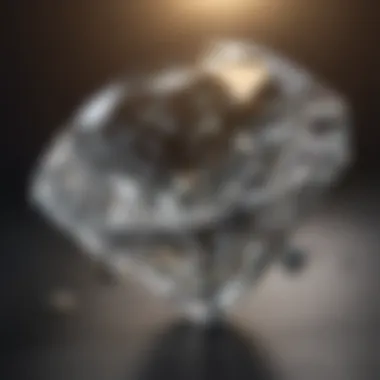
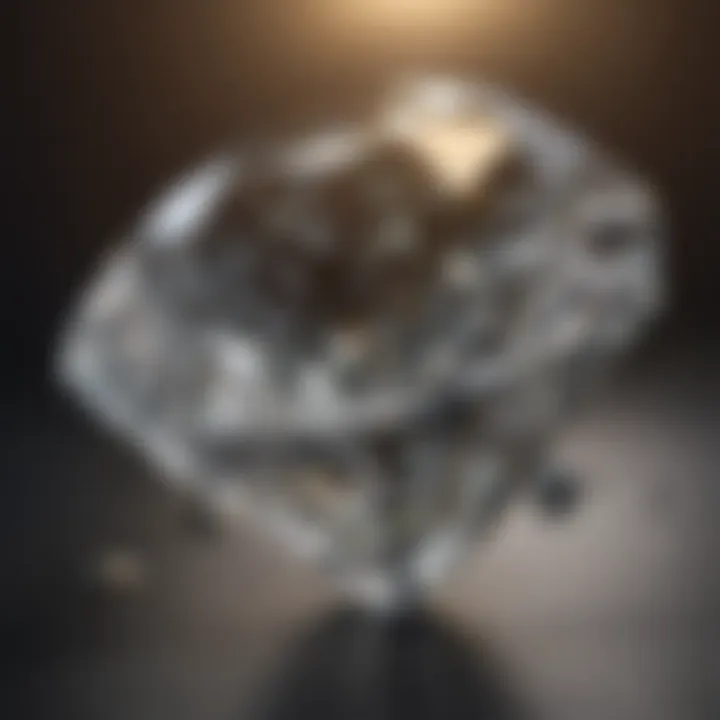
"Clarity not only measures absoluteness; it narrates the history of the diamond. Each inclusion represents a moment in time, a geological tale that deserves recognition."
Advanced Imaging Techniques
Technology has scaled newfound heights in the clarity evaluation of diamonds through advanced imaging techniques. Unlike the traditional methods involving manual observations, these modern tools employ sophisticated imaging to reveal the unseen attributes of each stone.
One prominent technique is called Phase Detection Imaging, which can visualize the internal structure of diamonds. This method captures how light travels through the diamond and how various inclusions affect its overall brilliance.
Another influential technique is 3D Imaging, allowing experts to construct virtual models of diamonds. By creating a detailed digital profile, they can pinpoint inclusions and flaws more precisely without physically altering the gemstone.
- Benefit of Advanced Imaging: Not only does this enhance accuracy, but it also contributes to the creation of educational material. Visualizing the diamond's internal characteristics aids potential buyers in understanding what sets an exemplary diamond apart from a flawed one.
- Considerations in Using Imaging Techniques: It’s essential to note that while advanced imaging techniques significantly enhance clarity evaluation, they also come with costs. Jewelers and gemologists must weigh the benefits against potential expenses.
In summary, advances in microscope usage and imaging techniques are critical for providing a clear assessment of a diamond's clarity. These techniques create bridges between ancient traditions and modern technologies, enriching our understanding of these precious stones.
Clarity and Light Performance
Understanding the relationship between clarity and light performance is crucial for anyone who wishes to appreciate diamonds fully. The clarity of a diamond influences how it interacts with light, which in turn affects its brilliance and overall visual appeal. When light enters a diamond, it travels through to the depths, reflecting and refracting as it goes. Any imperfections or inclusions within can disrupt this flow, causing the light to scatter in unintended ways. Consequently, clarity isn't just a label; it's a factor that shapes the diamond's very personality.
The Interaction of Light with Clarity
The interaction of light with clarity can be described as a delicate dance. A crystal-clear diamond allows light to pass freely, creating a dazzling display as beams are refracted within. However, when inclusions such as tiny feathers or crystals lurk inside, they can break up that pristine pathway. Light might bounce erratically, impairing the vibrant sparkle that collectors cherish.
In simple terms, here are ways in which clarity affects light performance:
- Transparency: Higher clarity means fewer obstructions for light. This allowed light to shine through enhances the diamond's sparkle.
- Brilliance: Clearer stones tend to reflect more light, making them appear more brilliant compared to their included counterparts.
- Fire: The dispersion of light into colored light—referred to as fire—can be diminished by internal flaws, dulling the spectrum a diamond can display.
It's vital to remember that not all inclusions are created equal. Some may only slightly affect light performance, while others can cause significant interruption. An observer with a discerning eye can often notice the difference, especially under different light conditions.
"Inclusions are like the fingerprints of a diamond, unique but sometimes unwelcome in the quest for brilliance."
The Role of Cut in Enhancing Clarity Perception
While clarity plays a significant role in how light interacts with a diamond, the cut is equally important. A well-cut diamond can enhance the appearance of clarity, even if it has some inclusions. The precision in cutting determines how well a diamond can reflect light. Factors that help in this enhancement include the proportions and angles of the facets.
For instance:
- Depth and Table Size: An ideal ratio can draw attention away from inclusions by reflecting light more effectively.
- Facet Arrangement: Unique shapes and sizes can manipulate the way light disperses, generating a face-up appearance that can make inclusions less noticeable.
- Polish Quality: The stones' surface finish matters, as a good polish can lead to cleaner reflections of light, adding to the diamond's allure.
Cultural Perspectives on Clarity
Exploring the cultural perspectives on clarity in diamonds offers a rich tapestry of meanings and values that transcend mere aesthetics. Different societies attach unique significance to clarity; it often encapsulates broader ideas about purity, integrity, and even status. In regions where diamonds symbolize commitment and endurance, clarity becomes not just a visual characteristic, but a metaphorical representation of the qualities we desire to see in ourselves or our relationships. This multifaceted nature of clarity shapes consumer preferences, artistic interpretations, and even marketing strategies within the diamond industry.
Symbolism of Clarity in Different Cultures
In various cultures, diamonds are more than just lustrous gems; they embody significant ideals. For instance, in many Western societies, a diamond's clarity is intimately tied to themes of love and commitment. A flawless diamond is often viewed as a representation of unbreakable bonds and pure love. This has led to the popular adage, "as clear as a diamond," often implying the importance of transparency in relationships.
Conversely, in certain Eastern cultures, clarity might connect more to notions of auspiciousness and prosperity. For example, the Chinese practice of Feng Shui incorporates the selection of pristine stones, believing that clarity enhances positive energy, boosting the fortune of the owner. To them, every inclusion or blemish can detract not just from the gem's appearance but also from its potential to attract good luck.
- Western Cultures:
- Eastern Cultures:
- Connected with love and commitment.
- "Clear as a diamond" signifies transparency in relationships.
- Tied to auspiciousness and prosperity.
- Clarity enhances positive energy and fortune.
Clarity as a Reflection of Character
The relationship between clarity in diamonds and personal character is deeply ingrained in societal perceptions. Many people believe that a diamond's clarity mirrors the clarity of intent and purity of character in the wearer. Possessing a high-clarity diamond can be seen as a statement of one's values and social status, suggesting not only affluence but also an eye for quality and an appreciation for finer things in life.
In this light, choosing a diamond with excellent clarity is often equated with making a conscious decision to reflect core values, such as honesty and integrity. This is especially pertinent in cultures where the diamond is presented as a token of commitment, where its clarity goes beyond just the visual to embody the virtues of fidelity and transparency in interpersonal relationships. It reveals a deeper narrative about the choices we make, reflecting who we are as individuals.
"The clearer the diamond, the clearer the intent of the heart that chose it."
In summary, understanding the cultural perspectives on clarity yields profound insights into how gems are appreciated, utilized, and symbolized in diverse societies. Each culture imparts its unique view, transforming the diamond from a mere stone to a bearer of meaning that resonates with personal and collective identity.
Choosing Diamonds: What to Consider
When it comes to choosing diamonds, the stakes can feel higher than a kite on a windy day. Clarity plays a pivotal role in this decision-making process. Understanding clarity and its implications not only helps in discerning the right diamond but also influences the strategy of investment in such a valuable gemstone. Each diamond comes with its unique character—shaped by its inclusions and the way light interacts with it. In this section, we’ll delve into considerations that every gemstone enthusiast, whether collector or designer, should keep in mind.
Tips for Evaluating Clarity
Evaluating a diamond's clarity is no small feat; it involves close examination and a practiced eye. Here's a couple of pointers to consider:
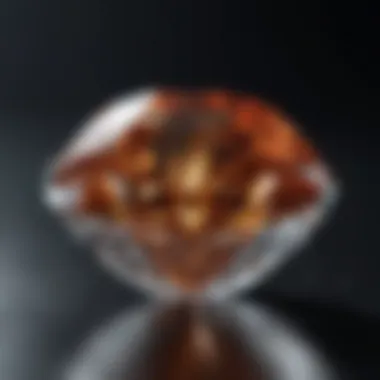
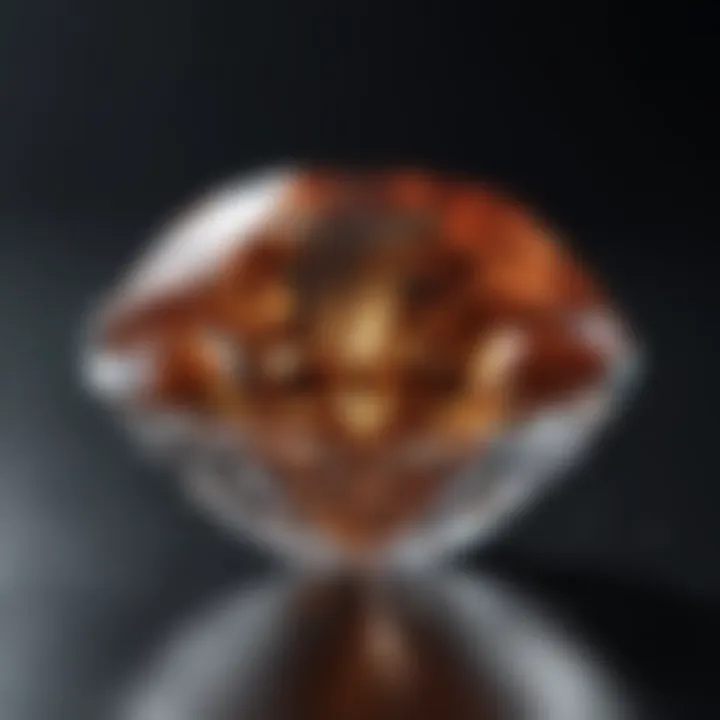
- Use of Magnification: A 10x jeweler's loupe is your best friend when assessing a diamond. This allows you to spot inclusions that are invisible to the naked eye.
- Look for Types of Inclusions: Inclusions can be various—feathers, crystals, or even clouds. Understanding these types can give you insight into the diamond's quality.
- Assess the Location of Inclusions: Not all blemishes are created equal. If inclusions are hidden under facets, they may be less bothersome than if they're visible from the top.
- Check for Transparency: The clearer the diamond, the more brilliantly it reflects light. Examine consistency in its interior.
- Compare with Other Diamonds: Visiting multiple jewelers, you'll find diamonds graded the same but appearing differently. A side-by-side comparison offers perspective on what suits your aesthetics.
By following these guidelines, you’ll be armed with the knowledge to make an informed choice.
Balancing Clarity with Other Factors
A diamond isn’t all about clarity; it’s a multifaceted decision involving several elements to strike the right balance. Here are some crucial factors:
- Cut: The diamond's cut greatly influences how its clarity is perceived. A well-cut diamond will reflect light beautifully, often making minor inclusions less noticeable.
- Carat Weight: Often, people might compromise on clarity for larger stones. A bigger diamond with a slightly lower clarity might still sparkle like the sun if the cut is superb.
- Color: A clear diamond can still appear dull if it has a yellow tint. Balancing color with clarity enhances the overall visual appeal.
- Shape: Different shapes can hold onto light in various ways, affecting how inclusions are seen. For instance, a round shape generally disguises inclusions better than an emerald cut.
- Personal Preference: Ultimately, beauty is in the eye of the beholder. Some categorically prefer perfect clarity while others appreciate character in their stones.
"When selecting a diamond, keep in mind that clarity is just one piece of the puzzle. What matters is harmony among all elements."
Understanding these elements allows buyers to prioritize based on their values, ensuring a fulfilling selection process.
Misconceptions About Diamond Clarity
In the world of diamonds, clarity stands out as a critical component influencing both aesthetics and value. However, misunderstandings about this fundamental aspect abound, often owing to a combination of myths, half-truths, and a lack of clear information. Addressing these misconceptions is crucial for consumers, jewelers, and collectors alike. A clearer grasp of what clarity entails can steer potential buyers toward making informed decisions that align with their preferences and expectations.
Common Misunderstandings in the Industry
Many individuals harbor the notion that clarity is solely about the absence of imperfections. This viewpoint, while understandable, oversimplifies the complexity surrounding diamond clarity. The reality is that diamonds possess a range of inclusions and blemishes—features that can add character, and, in some cases, enhance value. For instance, the presence of a unique inclusion, such as a crystal or feather, may not detract from a diamond’s allure, but rather contribute to its story, much like the wrinkles on a wise face.
Another widespread belief is that eye-clean diamonds always represent the pinnacle of clarity. In truth, an eye-clean diamond, while undoubtedly appealing, may still house inclusions when viewed under magnification. It's not simply about how a diamond looks on the surface. Evaluating clarity requires a closer examination to reveal what lies beneath the shiny exterior. For example, a diamond graded as VS1 might still display imperfections that are invisible to the naked eye but can be spotted under a jeweler’s loupe.
Clarifying Myths Surrounding Clarity
A popular myth is that only flawless diamonds can fetch high prices in the market. Although the rarity of flawless stones certainly adds to their allure, the market is also responsive to unique characteristics found in diamonds with lesser clarity grades. A well-cut stone with subtle, intriguing inclusions may command a higher price than a perfectly clear diamond that lacks personality or warmth.
Moreover, there is a belief that color and clarity are independent factors when it comes to diamond quality. In reality, they intersect in how light interacts with the gemstone. A diamond’s clarity influences its ability to refract light; hence, even a slight inclusion can affect the visual sparkle, especially in stones that score lower on the color scale. To put it simply, clarity affects the beauty of the diamond just as much as its color does.
"Understanding clarity goes beyond numbers; it’s about appreciating the diamond’s journey and its unique features."
Lastly, many consumers think clarity ratings are universally standardized. The truth is clarity assessments can vary from one grading laboratory to another. Each institution, including the Gemological Institute of America, uses its own criteria and scales, leading to potential discrepancies. This highlights the importance of purchasing diamonds from reputable sources that provide comprehensive grading reports, ensuring transparency in the buying process.
Future Trends in Diamond Clarity Assessment
The landscape of diamond clarity is shifting, shaped by advancements in technology and evolving consumer preferences. Understanding these future trends is crucial for anyone involved in the gemstone industry, from collectors to jewelry designers. The focus on clarity is not just about aesthetic appreciation; it also dives deep into financial investment, sustainability, and ethical sourcing—all integral to modern luxury choices.
Technological Advancements
As technology marches forward, it offers unprecedented methods for assessing diamond clarity. With tools that weren’t imaginable a couple of decades ago, clarity evaluation has seen a significant revolution.
- Automated Screening: New imaging systems deploy artificial intelligence to analyze diamonds in mere seconds. This speeds up grading while enhancing accuracy. Automated systems can even spot inclusions that the human eye may miss, ensuring the highest level of precision in clarity assessment.
- Spectroscopy: This technique examines how diamonds interact with light on a molecular level. By assessing light absorption and emission, experts can determine clarity and identify specific types of inclusions more effectively.
- 3D Imaging: The advent of three-dimensional modeling helps visualize internal structures of diamonds. It provides gemologists with a comprehensive view of the inclusions that may affect clarity and enhances transparency in grading practices.
In a market that thrives on transparency, these tools not only streamline the grading process but also build consumer confidence through detailed reports that back up the claims of clarity and value.
Shifts in Market Preferences
Today’s consumers are not just purchasing diamonds; they are investing in meanings, values, and stories. As clarity assessment continues to evolve, so do the tastes and preferences of diamond buyers. Here’s what we’re seeing:
- Sustainability Focus: There's a growing awareness of ethical sourcing. Consumers increasingly prefer diamonds that are not only clear but also conflict-free. Clarity assessment now often includes evaluations of provenance. Buyers want to ensure that their diamonds tell a responsible story.
- Awareness of Inclusions: Consumers are beginning to appreciate the unique characteristics inclusions can bring to a diamond. Instead of shunning them outright, some buyers view unique inclusions as fascinating narratives or as markers that make their diamond one-of-a-kind.
- Personalization: The desire for personalized jewelry is on the rise. Buyers are looking for stones that reflect their individuality, leading to an increased interest in unconventional clarity grades and styles that break from traditional norms.
"In the world of diamonds, clarity is not just an objective measure, but an evolving dialogue reflecting deeper values and aesthetic choices."
The future of diamond clarity assessment is not monolithic. It's a tapestry woven from technological innovation and market sensitivities. Everyone, from gemologists to buyers, should stay abreast of these developments to ensure informed choices—both in purchasing and in crafting beautiful jewelry.
Closure: The Essence of Clarity in Diamonds
The clarity of a diamond lies at the very heart of why these gemstones are so cherished. It serves not merely as a metric for grading, but as a benchmark against which beauty and value are often evaluated. In this exploration of diamond clarity, we’ve highlighted how each unique facet of clarity impacts not just the stone itself but also the perceptions of those who admire or acquire them.
Clarity encompasses physical characteristics like the presence of inclusions while also influencing light performance. A flawless diamond captures light in a manner that makes it glimmer with unparalleled brilliance. Conversely, a stone with visible blemishes or inclusions can appear less radiant, potentially affecting its desirability in the market.
Furthermore, understanding the grading scale and how various types of inclusions interact with light can aid consumers in making informed purchasing decisions. For jewelry designers, insights into clarity can help shape design choices that maximize a stone’s potential.
In the ever-evolving jewelry market, preferences around clarity are shifting. Cultures might emphasize clarity in distinct ways, linking it with ideals of purity, wealth, or even personal integrity. Thus, clarity not only informs the quality of the diamond itself but also shapes cultural narratives surrounding it.
"A diamond’s clarity is akin to a window into its soul; the clearer the view, the more mesmerizing the experience."
Recap of Key Insights
- Clarity is critical when determining diamond value and desirability, linking closely with light performance and aesthetic appeal.
- Types of inclusions impact both perception and gradation. For instance:
- Cultural perceptions of clarity influence purchasing decisions, with different societies attaching varied meanings to clarity and its absence.
- Advances in grading technologies are redefining how clarity is assessed, potentially leading to more standardized evaluations that transcend traditional views.
- Crystal inclusions can create sparkle, yet draw attention away.
- Feather inclusions may weaken the stone and reduce its clarity assessment.
Final Thoughts on Clarity's Role
The role of clarity in the realm of diamonds is an intersection of science, art, and emotion. Each gem tells a story that extends beyond its physical properties; it expresses the values of those who choose to adorn themselves with it. Beyond the price tag, clarity represents the purity of design, the intention behind each selection, and the ongoing narrative of human connection through these stones. So, when choosing a diamond, whether for personal wear or as part of a collection, remember that clarity is more than a number—it reflects the essence of the gem and the journey it represents.
Being educated on clarity helps in appreciating diamonds not just as commodities, but as treasures with their own distinctive narratives. This holistic understanding fosters a deeper connection to the beauty and significance of each stone, making the investment meaningful on more than just a monetary level.



